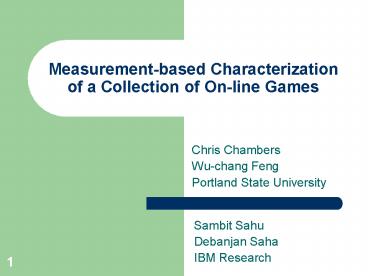Measurement-based Characterization of a Collection of On-line Games - PowerPoint PPT Presentation
Title:
Measurement-based Characterization of a Collection of On-line Games
Description:
Measurement-based Characterization of a Collection of On-line Games Chris Chambers Wu-chang Feng Portland State University Sambit Sahu Debanjan Saha – PowerPoint PPT presentation
Number of Views:97
Avg rating:3.0/5.0
Title: Measurement-based Characterization of a Collection of On-line Games
1
Measurement-based Characterizationof a
Collection of On-line Games
- Chris Chambers
- Wu-chang Feng
- Portland State University
Sambit Sahu Debanjan Saha IBM Research
2
Overview
- Background on on-line games
- Research questions
- Data sources
- Observations
- Characterizing gamers
- Predicting game workloads
- Sharing infrastructure
- Content delivery
3
Background
- On-line games are big business
- 60 of all Americans play video games (IDSA
report, 2003) - MMO games
- 4,000,000 World of Warcraft subscribers paying
monthly fees - FPS games
- 100,000 Counter-strike players at any given time
- RTS games
- gt8 million Warcraft game copies sold
- 200,000 Warcraft 3 games played online / day
- Hosting games very costly (30 of revenue)
4
Research questions
- How can we ease the burden of hosting an on-line
game? - How tolerant are gamers to bad service?
- How predictable is the gaming workload? How
tightly can we provision? - Can games be hosted with other interactive
applications ?
5
Data Sources for On-line Gaming
- Traditionally difficult to acquire
- Game companies dont want to share data (NDA)
- On-line games are costly to host
- Measurement research focused on short timescales
- Packet sizes, distribution
- On the order of hours
6
Data Sources for On-line Gaming
- Content delivery network for FPS games
- Individual player information from a
Counter-strike server - Total population of a variety of games
STEAM Sept 2004 Apr 2004 6.19TB served 3.14
GB/s average
CS.MSHMRO.COM April 2003-April 2004 2,886,992
connections 493,889 unique players
GAMESPY Nov 2002-Jan 2005 550 games 337.8k player
years
7
Observations
- Observations are specific to our data sources
(FPS, public-server) - Hope is techniques can be applied to other game
data
Gamers
Games
Content Delivery
8
Observations
- Observations are specific to our data sources
(FPS, public-server) - Hope is techniques can be applied to other game
data
Gamers
Games
Content Delivery
9
Gamers as individuals
- Gamers are impatient
- Negative exponential response to full server
- Only 16 will tolerate one retry at connection
- Gamers have short attention spans
- Average session time 15 minutes
- Many departures after a few minutes
10
Gamers are not loyal
- Why would they be?
- Simplicity
- Community
- Stickiness
- Why wouldnt they be?
- Many choices
- Measuring repeated sessions on our server
- Results
- 42 return once
- 81 return lt 10 times
- Dedicated players exist
11
Gamers reveal waning interest
- Interest in a game varies per user, but
eventually they all quit - Game providers would love to know how to predict
this - Measure individuals play history session times
and intersession times - Compute average player history
- Our data is too sparse to predict player interest
individually
12
Gamers reveal waning interest
13
Game populations
- Measuring the Gamespy dataset
- Key Questions
- What is the distribution of game popularity?
- Over what timescales are game populations
predictable? - What is the likelihood of multiplexing games with
other applications?
Gamers
Games
Content Delivery
14
Game popularity follows a power law
- Measure top 50 games in rank order once a day
- Average rankings over the year
- Independent of game popularity fluctuations
- Roughly straight line on log-log graph
- Popularity between ranks differs by orders of
magnitude - MMOs also seem this way
15
Game workloads predictable over short timescales
- Games are periodic
- Daily / weekly
- Variation from week to week very small
16
Game workloads unpredictable over long term
- No monthly periodicities
- Synchronized by external events
17
Game multiplexing
- Is there benefit to hosting multiple games
together? - Is there benefit to hosting games and web servers
together?
18
Game loads are synchronized
- 4 games
- Varying popularities normalized
- Little opportunity for multiplexing
19
Game and web loads are synchronized
- Web data source
- One week
- International beverage corp.
- Half-life vs. web
- Little opportunity for multiplexing
20
Bottom line on multiplexing
- Interactive online applications follow the same
day/night usage patterns - Multiplexing shows little benefit if latency is a
factor
Gamers
Games
Content Delivery
21
Content delivery
- Steam network gives us authentication data
patches - Can estimate patch bandwidth by subtracting
scaled player count - Bandwidth is large (30 of weeks CDN b/w)
- Future build a model for patch delivery
22
Conclusions
- Gamers
- Not loyal to public-servers
- Predictable lifecycles
- Games
- Hard to provision for popularity
- Easy to predict load from week-to-week
- Multiplexing games/web or games/games unlikely
- Patching
- Significant resource consumption
23
Questions?
24
Gamers are impatient when connecting
- Measure repeated connections to the server
(jamming) - Two refused connections and then a disconnect gt
patience for one refused connection - Results
- Negative exponential distribution
- Players very impatient
25
Gamers have short attention spans
- Measure session times
- Results
- Not negative exponential
- high rate of departure for short sessions
- Fitted with Weibull
- Why? Many servers to choose from































